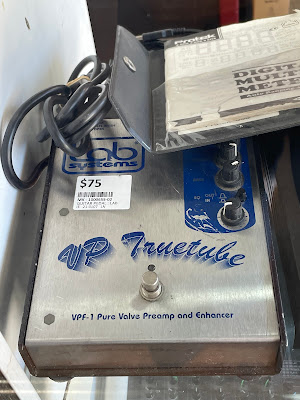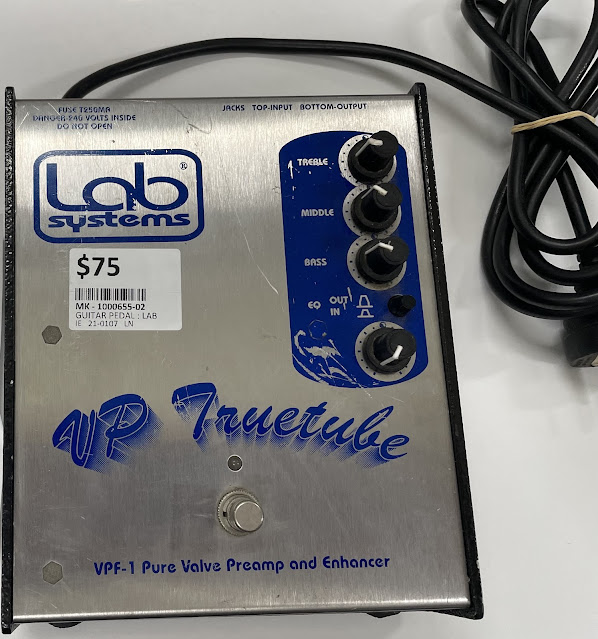I had a rough start to the working week last week, so a bit of retail therapy was in order. Going to my favourite hock shop I saw this with a $299 price tag. A piece of 1973 ancient history/juvenilia from one of the most iconic synth makers of all time; a bizarre unique design (and nomenclature); a very good price; and a cool FX pedal to boot? Hell yes!
It did not disappoint. The Funny Cat AG-5 is a unique design that has an "SDS" distortion, (over) drive section switched in and out on the right, and a rather unique envelope filter ("Harmonic Mover") switched on the left that, on at least one of its three settings, has an attack that is just like a cat's meow (hence the name). It was a contemporary of the similarly oddly named, but now highly sought after, Bee Baa two stage fuzz pedal, that sells for even more that this little guy (which itself has an
indicative sold price hovering around $500 AUD on Reverb).
The physical design is pure 1973, a solid sheet steel enclosure that takes up a fair chunk of space, mechanical foot switches, battery operation only, and controls out of harms way and out of sight/out of mind of the guitarist - all on the back (audience) side of the unit.
Controls are straightforward - an output level adjust for the SDS, a mix control between the Harmonic Mover output and whatever goes into it from the SDS footswitch, and three envelope responses for the Harmonic mover. In keeping with the time it was made, the circuit is buffered at all times and has a rather low input impedance - true bypass loving tone questers look elsewhere!
I tested it with my Yamaha active pickup bass, and it could range from hard to tame, with the Harmonic Mover ranging from nasty-in-a-good-way (on the fastest envelope setting) to remarkably musical on the more docile setting. The crazy filter circuit (a transistor warping an RC circuit) has a unique character.
The unit opens up easily-there are four thumbscrews on the side, two of which serve as a hinge for the bottom plate when loose, and two that can swing out of the body.
The insides look just how they would have in 1973-note the green stuff around the screws, jacks and pots - this would be Loctite adhesive or similar, that has done a stellar job of holding everything together for half a century, despite the beating the outside case has taken. The cleanliness of the inside is also a tribute to the well-sealed enclosure, and the little steel box for the battery is a nice touch. Note also the "blind hole" between two of the pots-there is another between the footswitches under the circuit board. The case was common to the Bee Baa, which had an extra pot and footswitch.
Check out the copper patches on the circuit board-the rest is silver because it would have been soldered in a "solder bath", but these areas would have been masked off with Kapton tape or the like to keep solder out so parts could be attached later. Hmmm, let's have a look to see what they are...
So why does it have three little circuit boards sticking out, when they could have been put onto a single bigger card? To answer this, we have to consider how things were in audio electronics in 1973.
A few years before, largely due to the genius of Bob Widlar, the monolithic (ie "chip") operational amplifier (opamp) had revolutionised electronics. A compact, accurate, versatile amplifier was now something that could make electronic design easy, rather than using traditional cascaded transistor based circuits with complex assembly due to lots of parts.
Problem was, these new little wonders were expensive. Even the uA741, which is remembered now as middling at best, cost about $5 US each in 1971, and for a cost conscious Japanese guitar pedal builder this was probably a deal-breaker.
At the time there was an alternative used in high-end mixing consoles due to the limited gain-bandwidth performance of early IC opamps, which limited their ability to amplify weak signals such as microphones while keeping the full audio spectrum intact. Companies like Neve and API made opamps from "discrete" parts (ie old-fashioned transistors and resistors) on a little submodule, and these are still made today by and for recording equipment purists, despite ICs having long-since caught up.
So what did Roland do? Unlike the Bee Baa, which has the old-fashioned cascading transistor technology, the Funny Cat was based around the new opamp tech but used cheap-and-cheerful roll-your-own opamp modules. As transistor matching is important for opamps, it is my guess that individual modules needed to be quality tested for performance before they could be soldered in.
There are good transcriptions of the main Funny Cat circuit around, and people have managed to sell clone PCBs of it, but the clones all use IC opamps which will not have the organic imperfections of the original. I believe this is so because the opamp modules do not appear to have ever been documented. Well, a fun Saturday evening later, that is no longer the case...

The circuit is very simple (though not as simple as, say, the Moog Modular CP3 opamp circuit). It is designed for low power usage and single supply operation, with a Class A output (no crossover distortion, unlike classic 1970s low voltage opamps such as the LM324 or LM358). Also, Roland made life more complex for themselves by putting the negative feedback resistor, usually an external component, on the opamp card. This means that the Funny Cat requires two different card types with different feedback resistors. It seems that Roland didn't trust the circuit to be stable with the feedback resistor on the "motherboard" and wanted to keep it very close to the transistors it bridged.
Anyhow, there goes a first look at a true original from Roland. While I love it, I have a feeling that some of the out-of-control behaviour with the Harmonic Mover is due to a dried-out low-range envelope capacitor - watch this space!























